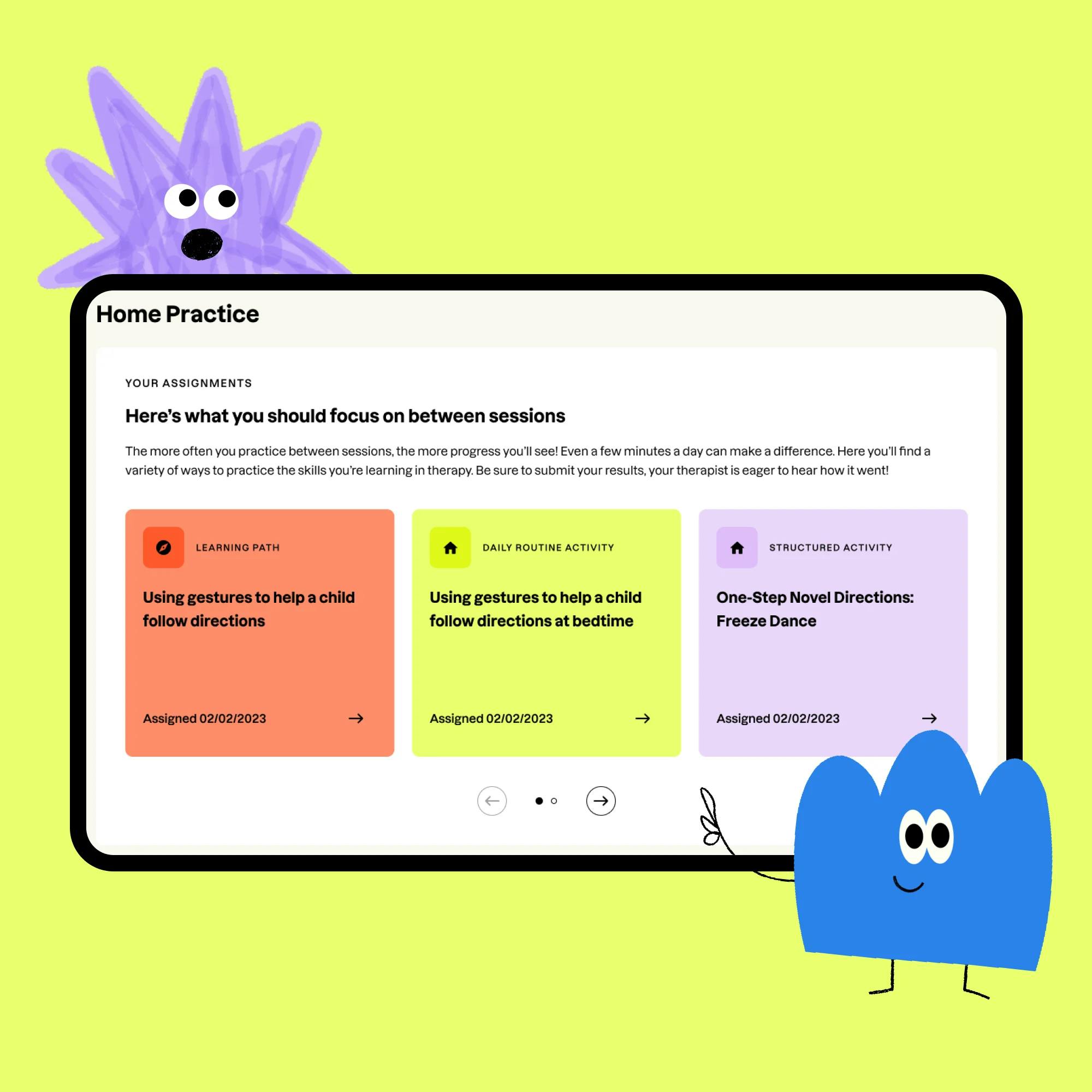Dysarthria is a condition that can make it difficult to speak clearly. Dysarthria commonly causes slurred or slow speech, as well as a variety of other problems that make it difficult for the person to be understood by others. Whether you're the one with dysarthria, or you’re a parent, caregiver, spouse, or family member of someone with this diagnosis, the effects can be frustrating. But there are treatments for dysarthria that can help. Here at Expressable, our licensed speech therapists work with people with dysarthria to help them speak more easily and share their thoughts and feelings with others. We’ve put together this expert guide to help you understand this condition, how it’s treated, and how caregivers and loved ones can support a person living with dysarthria.
Take our free screener
Do you want to improve your communication? Take our online screener and find out if you or a loved one could benefit from speech therapy.
 Start the screener
Start the screenerWhat is dysarthria?
Dysarthria is a motor-speech disorder that weakens the muscles used to produce speech. Dysarthria makes it difficult to coordinate and control these muscles, which can lead to a range of communication challenges. Dysarthria is often the result of damage to parts of the brain that control these muscles' movements. Dysarthria can affect many aspects of your speech. For example, a person’s speech may become slow, mumbled, or slurred. They may lose the ability to pronounce sounds and words correctly. They may be unable to control the volume of their voice or the quality and pace at which they talk. Because dysarthria involves muscle weakness, some individuals may drool excessively when speaking or have problems getting enough air in their lungs.


What causes dysarthria?
Dysarthria is often caused by damage to the brain and, in particular, to specific areas of the brain that are important for the motor aspects of speech. Dysarthria can occur at birth, which is called congenital dysarthria. But it’s often the result of an illness or injury. Some common causes of dysarthria include:
Tumors
Amyotrophic lateral sclerosis (ALS, also called Lou Gehrig’s disease)
Huntington's disease
Multiple sclerosis
Cerebral palsy
Muscular dystrophy
In addition to brain damage, dysarthria can be caused by damage to the organs involved in speech production. For example, someone who’s had surgery on their head, tongue, or voice box may develop dysarthria, as well as someone who has experienced trauma to their face or mouth. It’s important to note that dysarthria is not caused by issues that are more structural in nature, such as a cleft palate. While these issues may still lead to speech problems, they are classified as dysglossias. Dysarthria must involve damage to the brain or nerves.
What are the types of dysarthria?
There are several types of dysarthria. The type of dysarthria depends on where damage has occurred in the brain, the severity of this damage, and which muscles have been affected. There are also mixed dysarthrias that include features of more than one type. Diagnosing the type of dysarthria requires the trained expertise of a doctor or speech-language pathologist.
Here are the different types of dysarthria:
Spastic dysarthria: This type of dysarthria often results from damage to the central nervous system, which includes your brain and spinal cord. People with spastic dysarthria may have general speech problems such as strained or tense speech, in addition to muscle weakness and some abnormal reflexes.
Flaccid dysarthria: This occurs when there is damage to the peripheral nervous system: the nerves that connect the brain and spinal cord to the body. People with flaccid dysarthria often have trouble pronouncing consonants.
Ataxic dysarthria: There is a part of the brain called the cerebellum that receives sensory information that helps the body regulate its movements. Damage to the cerebellum can cause ataxic dysarthria. One of the hallmark symptoms is slurred speech.
Hypokinetic dysarthria: The brain’s extrapyramidal system coordinates our subconscious muscle movements. When it’s not working properly, it can cause a wide range of speech, voice, and swallowing symptoms.
Hyperkinetic dysarthria: The basal ganglia is a part of the brain that has a role in various functions and motor movements. Damage to the basal ganglia can cause a wide range of symptoms.
Looking for a speech therapist?
We offer personalized, 1-on-1 sessions at a time that fits your schedule. Get matched with a speech therapist today.
 Get started
Get startedWhat are signs and symptoms of dysarthria?
Dysarthria can affect your speech patterns in many different ways, depending on its cause. Some people with dysarthria may only have minor speech problems that still allow them to maintain everyday conversations without trouble. Others have more severe symptoms that make it difficult for other people to understand them at all. Typical signs and symptoms of dysarthria include:
Changes to the speed at which you talk; you may talk rapidly or very slowly
Speech that sounds slurred, mumbled, or choppy
Abnormal or varied rhythm in your speech
Difficulty controlling the volume of your voice
Difficulty controlling your facial muscles and moving your lips, jaw, and tongue
A nasally or hoarse voice quality
Trouble with chewing and swallowing
It’s important to know that dysarthria can affect more than just a person’s ability to talk. Because of limited movement of the facial muscles, a person may drool uncontrollably. It may also look like their face is drooping. In addition, dysarthria can affect an individual’s lungs, which causes their breathing to become irregular.

How is dysarthria different from aphasia or apraxia of speech?
Dysarthria, aphasia, and apraxia can all affect speech production and communication abilities. But there are notable differences. A correct diagnosis is important to make the most informed treatment decisions.
Dysarthria vs. aphasia
Both dysarthria and aphasia (sometimes called dysphasia) can happen after a stroke, and they can even present at the same time. However, dysarthria more commonly affects a person’s speech, while aphasia affects their ability to understand language. Generally, a person with dysarthria has difficulty making speech sounds because of muscle weakness. People with aphasia have limited ability to understand language, find the right words when speaking, or use appropriate sentence structure.
Dysarthria vs. apraxia of speech
Your brain sends messages to your mouth instructing your muscles how and when to make sounds. Apraxia of speech happens when these signals are disrupted. Apraxia makes it difficult for people to communicate intelligibly and form coherent sounds, phrases, and sentences. While acquired apraxia of speech can happen as a result of brain injury, it is not necessarily due to muscle weakness like dysarthria.

How common is dysarthria?
The overall prevalence of dysarthria is not well understood. However, based on information from the American Speech-Language-Hearing Association (ASHA), here are some estimated figures for how often dysarthria occurs after common neurological disorders:
Stroke: An estimated 8% to 60% of people who have a stroke present with dysarthria.
Traumatic brain injury: About 10% to 65% of people who experience a traumatic injury to their brain will develop dysarthria.
Parkinson's disease: Between 70% to 100% of people with Parkinson’s disease will develop dysarthria.
Multiple sclerosis: An estimated 25% to 50% of people with multiple sclerosis develop dysarthria at some point.
Amyotrophic lateral sclerosis (ALS): Almost all people with ALS will develop dysarthria in the later stages of their diagnosis. It is estimated that roughly 30% of people show signs of dysarthria when ALS is first diagnosed.


How is dysarthria diagnosed?
If you have any trouble with speaking, you should see your doctor right away. Your doctor may conduct a physical exam and order tests to determine the cause of your symptoms. These tests may include an MRI or CT scan of your neck and brain; an electromyography test, which is done to test the function of your muscles and nerves; blood tests; and more. In many cases, your doctor will refer you to a speech-language pathologist, also known as a speech therapist. Speech therapists are communication experts, and they are the most qualified professionals to evaluate, diagnose, and treat dysarthria. A speech therapist can determine whether you have dysarthria or another speech and language problem, along with the severity of your condition. They will evaluate how well you move the muscles in your face (your mouth, lips, and tongue) and how well you breathe. Your speech therapist will also listen to your speech patterns, including how well you say single words, say sentences, and speak in conversation. Finally, they will assess your vocal quality.


How is dysarthria treated?
There are a number of ways that dysarthria can be treated by your doctor. Treatment also includes speech therapy. Your doctor and your speech therapist will develop an individualized treatment plan for you based on your diagnosis and symptoms.
Medical treatment for dysarthria
As explained above, dysarthria has a wide range of causes, including stroke, head injury, brain tumor, a congenital disorder like cerebral palsy, or a degenerative disease like ALS or Parkinson’s disease. Your doctor’s treatment recommendations may depend on the cause of your dysarthria. For example, if dysarthria is related to the side effects of a medication, they may suggest you change your regimen. If it’s caused by a brain tumor, they may recommend surgery. In many cases, your doctor will suggest treatment from a speech therapist to improve the communication problems associated with dysarthria.


Speech therapy treatment for dysarthria
Your speech therapist will develop a personalized treatment plan designed to help you regain normal speech and meet your communication goals. Your speech therapist will help you:
Strengthen your speech muscles
Increase the movement of your lips and tongue
Articulate your words for clearer speech
Adjust the rate and pace at which you talk
Increase your breathing support for louder speech
Practice communicating in real-life situations
Provide your family with strategies for easier communication
If you have severe dysarthria that significantly affects your ability to communicate, your speech therapist may recommend alternative communication methods. These can include using visual cues, writing, and gestures to get your message across, as well as a computer or electronic device. These tools are referred to as augmentative and alternative communication (AAC).


Tips for coping and communicating when you have dysarthria
If you have dysarthria, there are simple techniques you can use every day to communicate more effectively. While your speech therapist will be able to provide more tailored recommendations, these tips are a good place to start.
Slow down: Try to relax, stay calm, and speak more slowly. This can help listeners understand what you’re trying to say and give them more time to interpret what they’re hearing. Remember to pause and take a breath when you need to.
Make sure listeners understand: Pause once in a while when speaking and have the listener confirm that they understand what you’re saying.
Keep it short: If speaking starts to feel exhausting, try to communicate your thoughts in as few words as possible. Fatigue can make your speech harder to understand.
If you’re unable to use words, have a backup plan in place for communicating, such as a notepad and pen.
Find other ways to communicate: If you’re unable to use words, have a backup plan in place. For example, you may want to carry a notepad to write down your messages. You can also type them in a cell phone to present to your listener. Additionally, gesturing and pointing to objects of interest can go a long way in communicating your thoughts.
Talk face-to-face: While not always possible, it's helpful to speak with people in-person versus on the phone. Be sure to make eye contact. This allows the listener to see how your mouth and lips are moving, which may help them better understand what you’re trying to say.
Establish the topic: Get the listener on the same page by quickly establishing the topic of conversation, which will help them better interpret your message. For example, if you’d like to discuss what meal you’ll be eating later, start by saying “dinner.” This helps to ground the discussion.
Avoid noisy environments: Before you speak, turn down your music or television, or find a better location with less background noise.
Ed's inspiring story
A brain injury almost took away this professor's voice, but speech therapy, new AI technology, and his own determination changed everything.
 Read Ed's story
Read Ed's storyHow to communicate with someone who has dysarthria
If you're a family member, friend, or caregiver of someone with dysarthria, here are some easy ways to better understand what your loved one is trying to say.
Speak up if you don't understand: Pretending you understand someone when you don’t isn’t doing anyone any favors. So speak up and ask them to kindly repeat themselves. If you’re still having trouble, ask them to write down their thoughts.
Let them finish: If the speaker is struggling to get out the right words, give them time to collect their thoughts and finish their sentence. You never want to rush or pressure them.
Repeat what you understood: If you can only interpret a portion of what someone is saying, repeat back the part you understood and ask for clarification. This will save the person energy by not having to repeat the whole sentence again.
Treat them the same: It’s important to continue to involve loved ones with dysarthria in your conversations and talk to them as you would anyone else. This will ensure they don’t feel isolated.
Ask simple questions: If you’re struggling to understand what someone is trying to say, ask simple “yes” and “no” questions. Or ask them to write their thoughts down. This will help the flow of conversation.


How does online speech therapy work for dysarthria?
Expressable matches individuals and families with a licensed speech therapist trained to evaluate and treat communication problems due to dysarthria. All therapy is delivered online via face-to-face video conferencing. You can access our full treatment guide to dysarthria here.
Based on the client’s age, communication difficulties, and speech and language goals, the speech therapist will develop a personalized treatment plan. Adult clients can choose to attend sessions by themselves, but they’re encouraged to bring caregivers or family members along. Because sessions are online, loved ones can attend from wherever they are.


For toddlers and younger children, parents and caregivers are actively involved and should attend sessions alongside their child. Your speech therapist will teach you strategies and techniques to use at home to improve your child's communication. The more often your child practices what they’re learning, the faster they’ll make progress! At Expressable, the goal of dysarthria treatment is to help the person achieve the highest level of function for communicating in daily life. Dysarthria treatment focuses on:
Improving the efficiency, effectiveness, and naturalness of communication
Reducing frustration
Supporting functional communication between the client and their communication partners
There are two distinct approaches for treating dysarthria: restorative (or impairment-based) and compensatory. Restorative treatment involves helping the person regain communication skills they’ve lost. Compensatory treatment involves helping the person use other ways to communicate. The use of one or both of these treatment methods will vary depending on the client’s needs. For a person with a progressive disease, the goal of treatment may be to preserve or maintain communication abilities. For other clients, depending on when they were diagnosed and when they start speech therapy, treatment may lean more compensatory in nature, using augmentative and alternative communication (AAC) as needed.
Support beyond sessions: The Expressable portal
Your speech therapy doesn’t stop when the session ends. At Expressable, you and your loved ones will get access to our client portal, which makes practicing communication strategies easier and more effective. Here’s what you’ll find:
Learning Paths that explain and reinforce what you’re learning in therapy, like using breath support or clear speech strategies
Demo videos that show real techniques in action
Home practice activities you can do during your everyday routine
Text messaging support so you can ask questions, get reminders, or receive tips from your therapist between sessions
By using the tools in the portal and practicing regularly, you can make faster progress and build more independence in your communication.
Find a speech therapist with Expressable
If you’re looking for support for dysarthria, reach out to Expressable today. We’ll match you with a licensed speech therapist who can perform an evaluation and help you figure out the best plan going forward. Start our simple sign-up here!
How Expressable Can Help
Concerned your child isn't reaching age-expected milestones? Looking for communication support from a professional? Expressable is a national online speech therapy practice serving children and adults. We treat all major areas of communication and feeding, offer flexible hours including evenings and weekends, and accept most major health insurance plans. We’re proud to have earned more than 3,000 5-star reviews from our clients (4.9/5 average).
Our therapy model is centered on parent and caregiver involvement. Research proves that empowering caregivers to participate in their loved one’s therapy leads to better outcomes. That’s why we combine live, 1-on-1 speech therapy with personalized education and home practice activities for faster progress.
Communication is more than words. It’s how we share how we feel and show who we are. We’re here to help you or your child do just that.
 Abby Barnes, M.S., CCC-SLP
Abby Barnes, M.S., CCC-SLP







